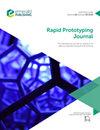用x射线技术测定增材制造金属部件的电池尺寸/结构和机械性能
IF 3.6
4区 工程技术
Q1 ENGINEERING, MECHANICAL
引用次数: 0
摘要
增材制造(AM)是一种快速发展的范式,通过允许定制创建具有增强性能的结构部件,已经显示出与传统减法加工程序相比的显着优势。大量的研究表明,在各种合金中发现新的亚稳亚结构对AM组件的技术质量产生了深远的影响。因此,本研究的目的是确定胞体结构参数对其力学响应的影响。设计/方法/方法最初,提出了一种测试多孔材料的方法,重点是静态拉伸测试。为了对所产生的细胞结构进行定性评价,使用了计算机断层扫描(CT)。然后,使用CT扫描仪对样品进行分析,确定其实际相对密度,并进行详细的几何分析。实验研究表明,在细胞形成过程中,细胞的形状对细胞结构的力学性能有显著影响。还确定了使用选择性激光熔化来生产最小单细胞尺寸约为2mm的细胞结构将是最合适的方法。研究局限/意义未来计划对细胞结构进行进一步的研究,以测试其静态拉伸强度。这项研究将对更多的样本进行,考虑到更广泛的细胞结构参数。另一个重要的步骤是对CT扫描得到的模型进行数值分析,验证静态拉伸试验的结果。采用选择性激光熔化机加工具有不同细胞结构的金属部件是非常重要的。然而,在目前的研究中,细胞大小和结构与力学性能的测定是非常新颖的。本文章由计算机程序翻译,如有差异,请以英文原文为准。
Determination of cell size/structures and mechanical properties of additively manufactured metallic components using X-ray technique
Purpose
Additive manufacturing (AM), a rapidly evolving paradigm, has shown significant advantages over traditional subtractive processing routines by allowing for the custom creation of structural components with enhanced performance. Numerous studies have shown that the technical qualities of AM components are profoundly affected by the discovery of novel metastable substructures in diverse alloys. Therefore, the purpose of this study is to determine the effect of cell structure parameters on its mechanical response.
Design/methodology/approach
Initially, a methodology was suggested for testing porous materials, focusing on static tensile testing. For a qualitative evaluation of the cellular structures produced, computed tomography (CT) was used. Then, the CT scanner was used to analyze a sample and determine its actual relative density, as well as perform a detailed geometric analysis.
Findings
The experimental research demonstrates that the mechanical properties of a cell’s structure are significantly influenced by its shape during formation. It was also determined that using selective laser melting to produce cell structures with a minimum single-cell size of approximately 2 mm would be the most appropriate method.
Research limitations/implications
Further studies of cellular structures for testing their static tensile strength are planned for the future. The study will be carried out for a larger number of samples, taking into account a wider range of cellular structure parameters. An important step will also be the verification of the results of the static tensile test using numerical analysis for the model obtained by CT scanning.
Originality/value
The fabrication of metallic parts with different cellular structures is very important with a selective laser melted machine. However, the determination of cell size and structure with mechanical properties is quiet novel in this current investigation.
求助全文
通过发布文献求助,成功后即可免费获取论文全文。
去求助
来源期刊

Rapid Prototyping Journal
工程技术-材料科学:综合
CiteScore
8.30
自引率
10.30%
发文量
137
审稿时长
4.6 months
期刊介绍:
Rapid Prototyping Journal concentrates on development in a manufacturing environment but covers applications in other areas, such as medicine and construction. All papers published in this field are scattered over a wide range of international publications, none of which actually specializes in this particular discipline, this journal is a vital resource for anyone involved in additive manufacturing. It draws together important refereed papers on all aspects of AM from distinguished sources all over the world, to give a truly international perspective on this dynamic and exciting area.
-Benchmarking – certification and qualification in AM-
Mass customisation in AM-
Design for AM-
Materials aspects-
Reviews of processes/applications-
CAD and other software aspects-
Enhancement of existing processes-
Integration with design process-
Management implications-
New AM processes-
Novel applications of AM parts-
AM for tooling-
Medical applications-
Reverse engineering in relation to AM-
Additive & Subtractive hybrid manufacturing-
Industrialisation
 求助内容:
求助内容: 应助结果提醒方式:
应助结果提醒方式:


